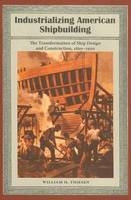
Industrializing American Shipbuilding
The Transformation of Ship Design and Construction, 1820-1920
2006
University Press of Florida (Verlag)
978-0-8130-2940-5 (ISBN)
University Press of Florida (Verlag)
978-0-8130-2940-5 (ISBN)
Spanning the transition from wood to iron shipbuilding in America, this history tells how nontheoretical methods of shipbuilding began to be discarded by the 1880s in favor of technical and scientific methods. It describes the trans-Atlantic exchange of technical information that took place during this era and the role of the US Navy in that.
Throughout the 19th century, the shipbuilding industry in America was both art and craft, one based on tradition, instinct, hand tools, and handmade ship models. Even as mechanization was introduced, the trade supported a system of apprenticeship, master builders, and family dynasties, and aesthetics remained the basis for design. Spanning the transition from wood to iron shipbuilding in America, Thiesen's history tells how practical and nontheoretical methods of shipbuilding began to be discarded by the 1880s in favor of technical and scientific methods. Perceiving that British warships were superior to its own, the United States Navy set out to adopt British design principles and methods. American shipbuilders wanted only to build better warships, but embracing British practices exposed them to new methods and technologies that aided in the transformation of American shipbuilding into an engineering-based industry. American shipbuilders soon improvised ways to turn U.S. shipyards into state-of-the-art facilities and, by the early 20th century, they forged ahead of the British in construction and production methods. The history of shipbuilding in America is a story of culture dictating technology. Thiesen describes the trans-Atlantic exchange of technical information that took place during this era and the role of the U.S. Navy in that transfer. He also profiles the lives of individual shipbuilders. Their stories will inspire enthusiasts of ships, shipbuilding, and shipbuilding technology, as well as historians and students of maritime history and the history of technology.
Throughout the 19th century, the shipbuilding industry in America was both art and craft, one based on tradition, instinct, hand tools, and handmade ship models. Even as mechanization was introduced, the trade supported a system of apprenticeship, master builders, and family dynasties, and aesthetics remained the basis for design. Spanning the transition from wood to iron shipbuilding in America, Thiesen's history tells how practical and nontheoretical methods of shipbuilding began to be discarded by the 1880s in favor of technical and scientific methods. Perceiving that British warships were superior to its own, the United States Navy set out to adopt British design principles and methods. American shipbuilders wanted only to build better warships, but embracing British practices exposed them to new methods and technologies that aided in the transformation of American shipbuilding into an engineering-based industry. American shipbuilders soon improvised ways to turn U.S. shipyards into state-of-the-art facilities and, by the early 20th century, they forged ahead of the British in construction and production methods. The history of shipbuilding in America is a story of culture dictating technology. Thiesen describes the trans-Atlantic exchange of technical information that took place during this era and the role of the U.S. Navy in that transfer. He also profiles the lives of individual shipbuilders. Their stories will inspire enthusiasts of ships, shipbuilding, and shipbuilding technology, as well as historians and students of maritime history and the history of technology.
William H. Thiesen, curator and director of operations of the Wisconsin Maritime Museum in Manitowoc, Wisconsin, has published articles in Mariner's Mirror, American Neptune, and International Journal of Maritime History.
| Erscheint lt. Verlag | 9.4.2006 |
|---|---|
| Zusatzinfo | 26 b&w photos, notes, bibliography, index |
| Verlagsort | Florida |
| Sprache | englisch |
| Themenwelt | Geschichte ► Teilgebiete der Geschichte ► Technikgeschichte |
| Geschichte ► Teilgebiete der Geschichte ► Wirtschaftsgeschichte | |
| Technik ► Fahrzeugbau / Schiffbau | |
| ISBN-10 | 0-8130-2940-6 / 0813029406 |
| ISBN-13 | 978-0-8130-2940-5 / 9780813029405 |
| Zustand | Neuware |
| Haben Sie eine Frage zum Produkt? |
Mehr entdecken
aus dem Bereich
aus dem Bereich
Buch | Softcover (2024)
Lehmanns Media (Verlag)
19,95 €
Vom Perceptron zum Deep Learning
Buch | Softcover (2022)
Springer Vieweg (Verlag)
19,99 €
Digitalisierung neu denken für eine gerechte Gesellschaft
Buch | Hardcover (2023)
Quadriga (Verlag)
20,00 €


